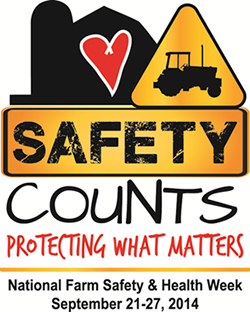Please note: As of 01/20/2025, information in some news releases may be out of date or not reflect current policies.
News Release
OSHA and agriculture community come together to promote safety education during National Farm Safety and Health Week Sept. 21-27
CHICAGO — The agriculture sector accounted for 479 deaths in 2013. With a fatality rate of 22.2 for every 100,000 full-time workers, agriculture recorded the highest fatality rate of any industry sector. Additionally, more than 49,000 injuries were recorded in 2012, the last year for which statistics were available from the Bureau of Labor Statistics. Agriculture employs more than 2 million people in the United States.
 |
The U.S. Department of Labor's Occupational Safety and Health Administration is supporting the National Education Center for Agricultural Safety's National Farm Safety and Health Week Sept. 21-27 by emphasizing the importance of worker safety in the industry. The theme for this year's National Farm Safety and Health Week is "Safety Counts: Protecting What Matters."
"Promoting safety and health on American farms and increasing awareness of the confined space, farm equipment, grain handling and other hazards in the agricultural industry has been a priority of OSHA, agribusinesses and farm agencies in recent years," said Nick Walters, regional administrator for OSHA in Chicago. "Protecting the safety and health of agricultural workers is important to all of us in the Midwest."
Farm Safety and Health Week has been observed during September annually since 1944 as farmers prepare for harvest. The NECAS has posted informational safety and health materials on its website at www.necasag.org.
Farmworkers are at high risk for fatal and nonfatal injuries, work-related lung diseases, heat exposure, confined-space hazards, noise-induced hearing loss, struck-by and fall hazards, skin diseases and certain cancers associated with chemical use and prolonged sun exposure. OSHA has additional information available on its website regarding specific agricultural hazards.
Additionally, a record number of deaths and injuries in 2010 led OSHA to develop a Local Emphasis Program for Grain Handling Facilities, focusing on the grain and feed industry's six major hazards, including engulfment, falls, auger entanglement, struck-by, combustible dust explosions and electrocution hazards.
In 2010, at least 26 U.S. workers were killed in grain engulfments, the highest number on record. OSHA has published information related to common grain industry hazards and abatement methods, proper bin entry techniques, sweep auger use and many other grain related topics at www.osha.gov/SLTC/grainhandling/index.html.
The Grain Handling Safety Coalition can also provide all the necessary training materials to train farmers, commercial grain handling employees, youth, rescue workers and more for free or at a reduced rate. There are five different safety topics available, including an overview of grain handling and storage safety, grain bin entry and entanglement, fall and confined space hazards. GHSC also offers "Train the Trainer" courses for companies and communities as a local resource for training. Approximately half of all farmworkers are Hispanic. OSHA requires that employers conduct all required training of workers in a language and vocabulary workers can understand. OSHA's Spanish-language outreach resources, which detail how employers can work cooperatively with OSHA, are:
- Hispanic Outreach Module of Compliance Assistance Quick Start, available at: https://www.osha.gov/dcsp/compliance_assistance/quickstarts/hispanic/index_hispanic.html
- Spanish-Language Compliance Assistance Resources, available at: https://www.osha.gov/dcsp/compliance_assistance/index_hispanic.html
- Podemos Ayudar (We Can Help), available at: https://www.osha.gov/as/opa/spanish/index.html.
To ask questions, obtain compliance assistance, file a complaint, or report workplace hospitalizations, fatalities or situations posing imminent danger to workers, the public should call OSHA's toll-free hotline at 800-321-OSHA (6742).
Under the Occupational Safety and Health Act of 1970, employers are responsible for providing safe and healthful workplaces for their employees. OSHA's role is to ensure these conditions exist for America's working men and women by setting and enforcing standards, and providing training, education and assistance. For more information, visit http://www.osha.gov.
Editors and producing wishing to interview local OSHA personnel on this important safety subject should contact the Office of Public Affairs at 312-353-6976.
